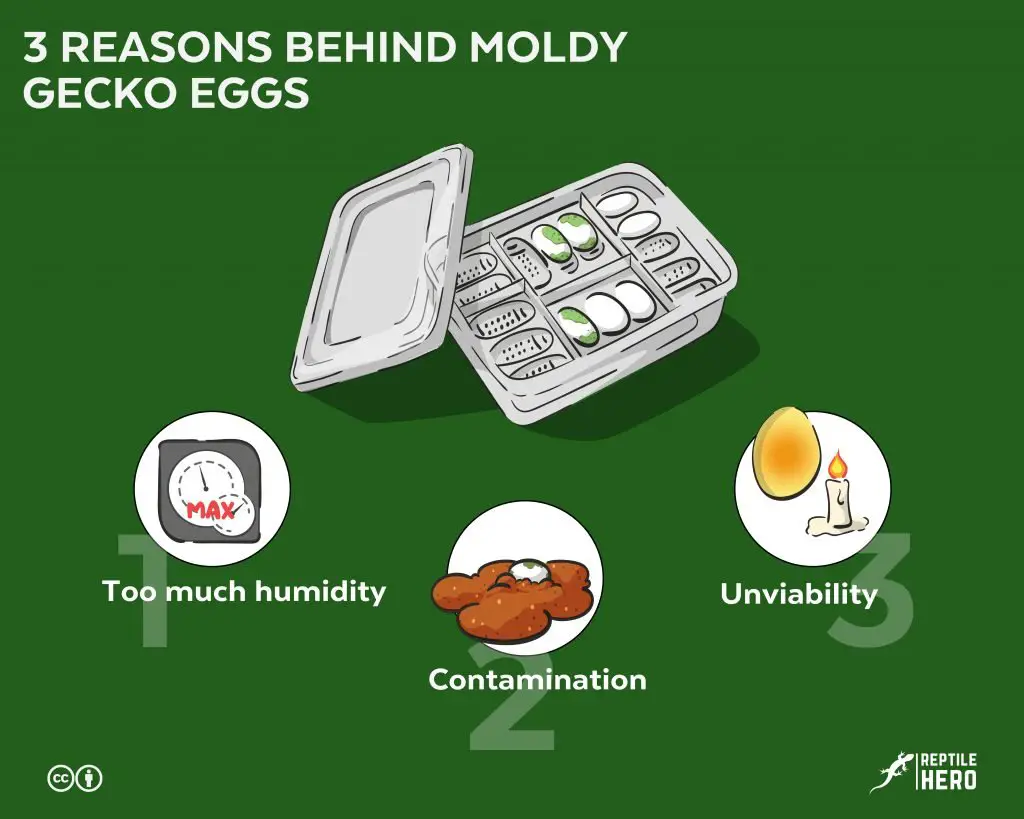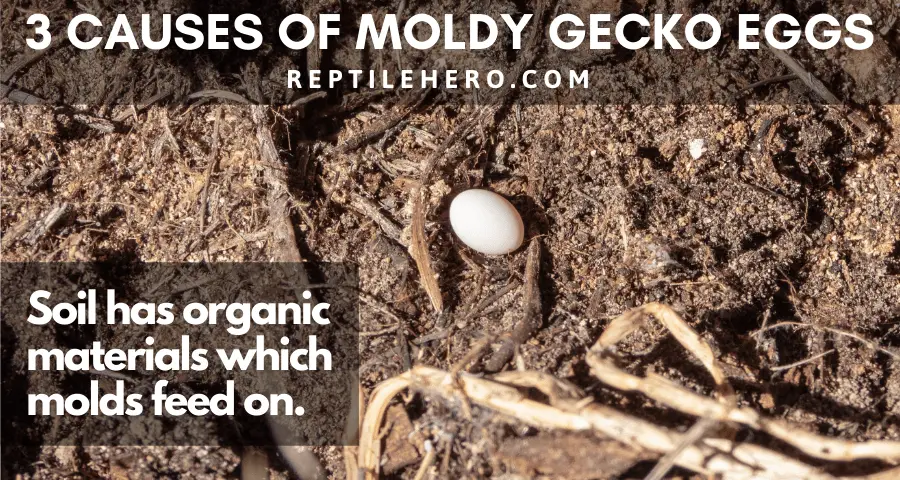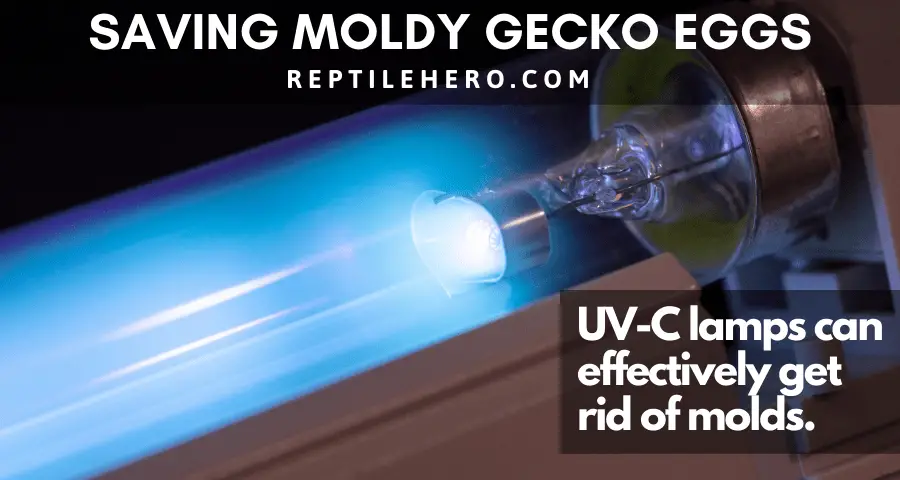Mold On Your Gecko’s Eggs? 3 Reasons, Solutions [and 8 Tips]
If you’ve ever had a moldy loaf of bread, you know that it’s best to chuck it straight into your trash bin. But is it the same for the moldy eggs of our little gecko friends? Does the presence of mold signal that it’s time to say goodbye to the gecko egg or can it still be saved?
Moldy gecko eggs are due to excessive humidity, contamination, and unviability. However, a moldy fertile gecko egg could still successfully hatch if cleaned, treated, and kept properly for the rest of its incubation period. A moldy egg should be disposed of when it collapses, gets discolored, leaks, and smells rotten.
Read on to learn more about moldy gecko eggs.
Moldy Gecko Eggs: The What & Whys
Pretty much all the new gecko hobbyists I know look forward to witnessing one thing in particular: hatching gecko eggs for the first time. So it’s understandably distressing to see mold forming on precious little gecko eggs. But is there really no hope in saving a moldy gecko egg?
What Do Moldy Gecko Eggs Look Like?
There is no single appearance of mold on gecko eggs. Although the most commonly reported mold on gecko eggs is usually a fuzzy white mass, some breeders have also seen green, red, brown, and black molds.
In fact, molds can also come in a variety of colors including orange, pink, and purple. The very same type of mold could also appear in different colors under different circumstances and can also change in color as time goes on.
However, color doesn’t really matter in determining how dangerous it is for you and your gecko [1]. And, not all molds produce toxic byproducts called mycotoxins. But even if not all molds are toxic, per se, it’s still best to find out what causes it and how to get rid of it.
3 Reasons Behind Moldy Gecko Eggs
Years back, most keepers attempting to hatch gecko eggs for the very first time were advised to never put any hope in moldy ones. People were saying that it would be a waste of time and effort because mold is a sign that an egg is no longer viable. But actually, that is not always the case.

#1 – Too Much Humidity
When the incubation container you are using is air-tight, never opened, or the incubation medium is too wet, you will definitely find your eggs developing mold because of too much humidity.
Different breeders recommend different levels of humidity but most say that both leopard and crested geckos do well incubated anywhere between 80-90%. Keep a close eye on the humidity within your incubation container and make sure it stays within the optimal range for successful hatching with a hygrometer (here on Amazon).
A sure sign of excessively high humidity levels – without having to check a hygrometer – is too much condensation in the incubator after a cool night. If it pools on top of your lid, it will most probably drop onto your gecko eggs and further increase the likelihood of mold formation. Your gecko egg may also seem as though it’s sweating when condensation forms on its cool surface.
#2 – Contamination

Experienced breeders have also pointed out how dirty or contaminated materials used in laying and incubation are likely culprits of molding as well.
One breeder shared that she only ever had significant mold problems when the eggs were laid straight onto her pets’ not-so-clean enclosure substrate instead of a clean new lay box. Because her female laid earlier than expected, the eggs were exposed to fecal matter still in the substrate. And her male crawling all over the eggs didn’t make the situation any better. Unfortunately, even after transferring the fertile eggs into a clean incubation set-up, they molded over in less than a week.
With that, it’s important to always look into what’s actually inside that package of incubation medium before adding it to your cart. Soil, for example, seems to be the most susceptible to mold. We can attribute this to the fact that soil usually has a lot of organic materials that the mold could easily live off on [2].
Even perlite or vermiculite can get contaminated. Certain brands may have traces of fertilizer that would essentially guarantee mold growth in a humid incubator. So it’s better to double-check and sterilize everything before using them for your lay box and incubator – from the container, the substrate, to the water you are planning to use.
#3 – Unviability
Lastly, a gecko egg becomes moldy when it’s a dud; it could either have been infertile from the start or the developing embryo might have died. In this case, it will mold over as early as the first few weeks or as late as a few days before hatching – basically at any point in time during incubation.
Personally, I wouldn’t tell you to toss it at the first sight of mold. Some breeders had the nastiest looking moldy egg still hatch after diligently taking care of it. You see, simply having moldy spots on your egg doesn’t mean it’s the end for your little buddy.
If all you see is mold growth, give it a chance. Candle your gecko egg to know whether or not it’s fertile. You can use a small flashlight. Here’s a short video on what to look for when candling:
If it’s fertile but still molding, it must’ve died due to improper incubation set-up. The humid environment and the breakdown of the organic materials in the egg serve as fertile grounds for molding. Sometimes, despite doing everything right, fertile eggs could still die. The exact reasons behind such cases are still unclear, but experienced breeders believe that defects could definitely be a factor.
Can You Still Save Moldy Gecko Eggs?
Breeders used to say that moldy eggs are unsalvageable and should definitely be thrown out immediately. However, more and more hobbyists are now advocating for doing anything and everything to save moldy gecko eggs, especially when it’s spotted early on. The debate is far from over and I personally think both sides have valid arguments.
3 Steps in Saving Moldy Gecko Eggs
Moldy discolored eggs can still hatch, experienced breeders will definitely agree with me on this. So do these 3 things before completely giving up on your moldy eggs.
#1 – Clean
First, clean off the mold. To avoid spores from spreading onto the good eggs, take out all the ones that have molded over and place them into another clean container or a piece of paper towel for cleaning. I’d recommend that you wear some gloves while doing this to avoid skin irritation and wear a face mask to avoid spore inhalation. Once you have separated the infected eggs, gently wipe off the mold spots with a cotton swab, piece of paper towel, or tissue paper.
Also, check the medium and container to see if they have any molds. If there are, disinfect them or create a new incubation set-up altogether – especially if your substrate isn’t meant to be reused.
Give the uninfected eggs a good wiping too just to be sure. Don’t reuse the cotton swab, paper towel, or tissue paper you’ve already used on the moldy eggs or incubator to avoid further contamination.
#2 – Treat

The most common way people treat moldy eggs after cleaning is with the use of antifungal powders (here on Amazon). Make sure the product has the active ingredient miconazole nitrate (2%) before buying it.
Some keepers prefer using their hands to ensure that the entire egg is treated, others go for a swab so they don’t accidentally grip on it too tightly. Either way, the powder should be applied liberally to fully coat the egg and prevent the regrowth of mold.
Others have also mentioned that some iodine solution or garlic juice could probably help treat moldy eggs as both have been proven to effectively eliminate numerous bacteria, yeast, and mold.
Seeing as povidone-iodine (here on Amazon) is commonly used on sick and injured reptiles [3] and for disinfecting fish eggs [4], I think it’s safe to use on geckos. Garlic, on the other hand, has me skeptical. Though it does have antifungal properties, I don’t think it’s safe since it’s used as a gecko repellent and geckos shouldn’t be fed garlic.
One alternative you can test out is UV light exposure. Just buy a UV-C lamp with a remote controller (here on Amazon) and place it near the moldy gecko eggs for at least 15 minutes to 2 hours.
Wear UV glasses and gloves when you are setting it up and leave the room after because direct exposure could damage your eyes and skin. After it turns off, make sure to air out the room and container well. Though I haven’t seen other gecko keepers try this out, I think it’s worth a try since it’s also used in disinfecting bird eggs without harming the developing embryos [5].
#3 – Keep
After properly treating a mold-infected gecko egg, make sure to isolate it from all the good eggs so you can better monitor it. Of course, if you find out that the main cause of molding was excessive humidity or material and egg contamination, make sure that its new incubation container has been set for optimal embryo development.
Check on your eggs weekly, don’t take them out of the incubating container or open it more often than that because they need the temperature and humidity to stay relatively constant.
If the medium was too wet, adjust your medium to water ratio. Breeders use different ratios and still successfully hatch their eggs – be it 1:1, 1:.08, or 3:2. Maybe because of the specific substrate or temperature and humidity in the room they are keeping their incubators in. Other keepers don’t even use scales and instead go by feel, they’d add more water or medium until it’s just moist enough.
If it was contaminated, it’s better to transfer all eggs to a new and clean incubator regardless of whether they had molded. Also, consider changing your substrate as certain laying and incubation mediums trigger mold growth even when it’s only moderately humid.
A friend of mine once shared how he heard that a few hobbyists used foams instead of traditional mediums for better humidity control, decreased chances of molding, and prevention of impaction. They would use a damp pad on the bottom for moisture, a pad with slits on top for the eggs to stay safely in place, and a few chunks of cut-up foams in between those layers for the eggs not to touch the damp bottom directly.
If they still don’t hatch after the expected hatching date but didn’t have any regrowth of mold, just give it a few more days – weeks even. Just be patient and don’t cut it open to force the gecko out, you could hurt and kill it if you do.
When To Trash Moldy Gecko Eggs
Like I said in the beginning, infertile and dead gecko eggs usually mold over quite easily. But fertile eggs could also mold over due to high humidity and contamination from incubation materials. That’s why I think it’s always better to keep looking after a moldy egg until I’m 100% certain it’s no good.
So yes – I do think that at a certain point, a moldy gecko egg can no longer be salvaged. At that point, the egg will also display a host of other unusual symptoms aside from mold growth. These include caving in, discoloration, leaking, and smelling foul (like a rotten egg).
When your egg displays all five of those even after treatment, it’s time to give up and call it quits. Save yourself from the unnecessary trouble and inevitable disappointment that you are sure to experience in trying to save a totally bad egg.
8 Practical Tips To Prevent Moldy Gecko Eggs
It can be tiring and scary to keep trying to hatch gecko eggs only to find them incredibly moldy and stinky each time you’ve attempted to do so in the past. So you should definitely keep the following tricks in mind to ensure that your gecko eggs don’t turn moldy on your next attempt:
- Disinfect everything before incubating the eggs.
- Choose a translucent incubating container so you can easily see when condensation accumulates on the lid and sides then wipe it off.
- Place a hygrometer inside your incubator so you can regularly check on your eggs without having to constantly open it unless you need to add water to the medium or let it air out to lower humidity.
- Add a maximum of ten pinholes to allow airflow into and out of the container. If your substrate dries out too quickly, just tape up some holes until it’s just humid enough.
- You could also opt to open the lid for about 5 to 15 minutes every week for ventilation.
- Change your medium to one that changes in color based on moisture level (here on Amazon) so it’s easier to tell when you actually need to add water. This type of substrate is usually also reusable so it’s an amazing choice if you’re planning to continue breeding your geckos in the future.
- Use an egg tray (here on Amazon) so that your gecko’s eggs are never directly in contact with water or highly saturated medium.
- Invest in a good programmable reptile egg incubator with a built-in pulse thermostat and a clear top like Zoo Med’s Reptibator (here on Amazon).
Some people have been claiming that spreading loose clumps of sphagnum moss around the incubator can easily solve mold problems. If you believe that as well, I’ve got news for you: that’s not true. It may actually do the exact opposite because it’s plant material that molds can feed on.
Takeaways
Gecko eggs become moldy because of excessive humidity, contamination, and unviability.
A moldy fertile gecko egg can definitely still hatch if cleaned, treated, and kept properly during its incubation.
Throw away a moldy gecko egg once it’s also become shriveled up, discolored, leaking, and stinky.
You can prevent fertile gecko eggs from getting moldy with disinfection, ventilation, and moisture control.
Sources
[1] https://www.cdc.gov/mold/faqs.htm
[2] https://www.epa.gov/mold/mold-course-chapter-1#Chapter1Lesson1

![Is It Possible To Overfeed A Gecko? [4 Signs]](https://www.reptilehero.com/wp-content/uploads/2021/12/overfed-gecko-cc-768x614.jpg)



![Do Geckos and Reptiles Dream in Their Sleep? [What Science Says]](https://www.reptilehero.com/wp-content/uploads/2021/07/Gecko-Sleeping-Infographic-768x614.jpg)
![Why Does Your Gecko Feel So Cold? [6 Potential Problems]](https://www.reptilehero.com/wp-content/uploads/2021/02/G43-768x614.jpg)